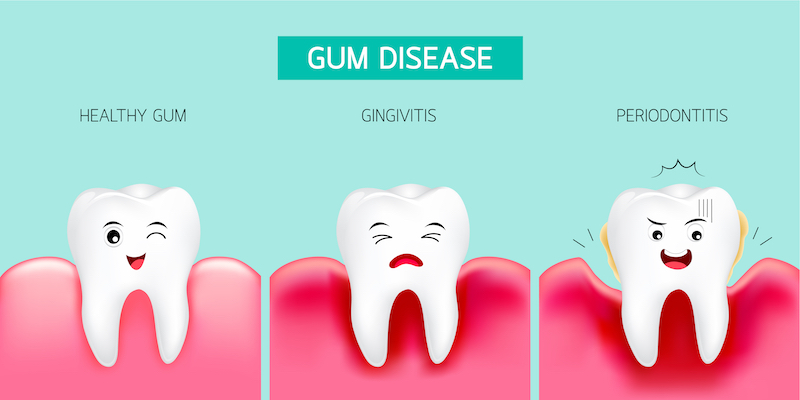Can I Restore Bone Loss Caused by Periodontal Disease?
4 Minute Read:
If you are suffering from periodontal disease and are at risk of or have already begun losing teeth, there is hope!
Time is of the essence, and you must seek help from a periodontist, a dental provider who specializes in the treatment of gum disease.

Severe gum disease doesn’t happen overnight. It takes time to progress, and, at every stage, there are interventions that can stop the progression in its tracks.
Depending on the severity of your gum disease, you have different treatment options to restore your periodontal health.
The Four Stages of Gum Disease
Stage 1: Gingivitis
Gingivitis is the first stage of gum disease, and it is characterized by gum inflammation, which occurs at some time or another in most people.
Regular professional dental cleanings and proper oral care can help treat or even reverse gingivitis. This includes brushing teeth and gums twice per day and flossing nightly.
Stage 2: Initial Periodontitis
Only 10 to 15 percent of people with gingivitis will progress to periodontitis. At this stage, tissues that connect the teeth to the jawbone begin to deteriorate, and mild bone loss begins. A procedure called scaling and root planing (deep cleaning) is performed to remove plaque and tartar deposits that have reached below the gum line to prevent the formation of periodontal pockets.
Stage 3: Mild Periodontitis
About 10 percent of patients with initial periodontitis will go on to experience mild periodontitis, but don’t let the name of this condition fool you; even mild periodontitis causes significant bone loss.
At this stage of gum disease, pockets have developed, and gums have begun to separate from the teeth (receding gums) due to chronic inflammation.
Multiple scaling and root planing sessions are recommended to allow gum tissue to reattach to teeth.
This approach requires strict compliance with the at-home teeth brushing, flossing, and using interdental brushes.
If this treatment fails, the next step is surgery to reshape the gums and bone and reduce the periodontal pocket size or, if that is not sufficient, your periodontist may recommend a procedure to regenerate gum and bone tissue.
Stage 4: Progressive Periodontitis
This final stage of periodontal disease involves loose, shifting teeth and painfully swollen gums, with or without abscess.
At this point, you are at imminent risk of losing some or all of your teeth, and eating has become quite painful. Severe or progressive periodontitis requires surgery in almost all cases.
Flap surgery is often the first surgical intervention to treat extreme bone loss, and a graft may be necessary to regenerate the underlying bone. This procedure is designed to create new bone tissue, reverse progressing deterioration, and save as many teeth as possible. Your dentist may also splint extremely loose teeth to stabilize them while your gums and underlying bone heal.
Reversing Periodontal Bone Loss With Regenerative Treatments
Controlling the progression of gum disease is the best way of reversing its course. The sooner it’s treated, the better chance you have that your gum disease can be reversed with lesser invasive procedures.
In severe cases of periodontal disease, more advanced treatments include surgery and grafting. The following procedures are now standard for the treatment of advanced periodontitis:
Pocket reduction surgery or osseous surgery removes built-up tartar and bacteria between the tooth roots and now separated gum tissue. It then reshapes the gum and bone to prevent further deterioration and potential tooth loss.
Regenerative treatments regrow gum tissue and bone to strengthen the jaw bone. Periodontal pockets are folded back and cleared of invasive bacteria. A thin membrane is inserted deep within the damaged gum tissue that allows the body to regenerate bone and gum tissue. This stimulates tissue growth and blocks faster-growing soft tissues from invading the area designated for slower-growing bone tissue.
You Don’t Have to Lose Your Teeth
The key takeaway is that early intervention is essential if you want to keep your smile healthy and beautiful. If circumstances cause you to advance to periodontitis, get help from a respected periodontist immediately.
Without intervention, gum disease will continue to progress. However, if you take good care of your teeth and gums, you can keep your smile healthy for the rest of your life!
Interested in Learning More?
If you are concerned about gum disease in Los Angeles or want to have your teeth cleaned, call Dr. Salamati’s office today at 310-275-1090 or contact us online. Our friendly staff is happy to schedule a consultation to check for gum disease or set you up with regular dental visits and cleaning appointments to keep your teeth and gums healthy.
